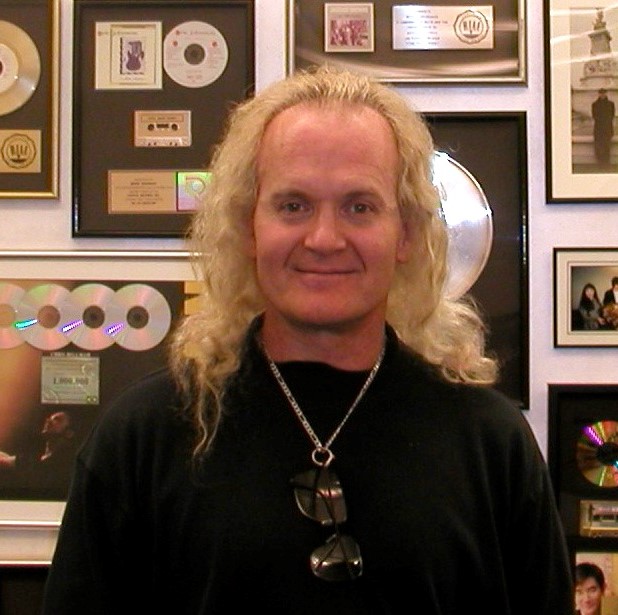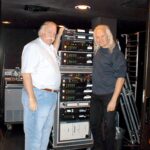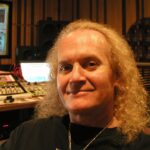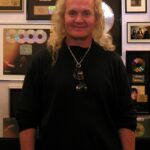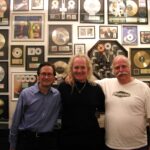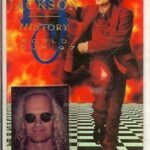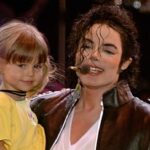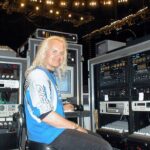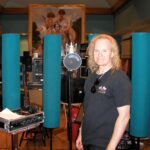Michael Durham Prince is a sound engineer who worked with Michael Jackson from 1995 to 2009. After he worked on the HIStory Tour, he became one of his closest collaborators in the 2000s, and became friends with Brad Buxer. Following the first two editions of the MJ MusicDay, we are happy to collaborate again with the Buxer-Prince tandem for two Making HIStory with MJ dates in Paris and Cologne. While setting up this event project, I asked him to do an interview because I was eager to immortalize his precious memories on the website. Thanks to his trust and availability, my wish was granted. During this conversation, one can hang Michael Prince every word as one can feel how much he lived through all this with passion, professionalism and humanity regarding Michael Jackson. It is now time to share it with you: I don’t want to keep it to myself because that’s what books and events are made for.
First, can you tell us how you grew a passion for music and sound, and made a career out of it?
My father was a musician and a composer. He wrote, “Boogie Woogie Bugle Boy” and other hits for artists before I was born. So, I had an interest in playing piano first and took lessons from the age of 7. I then started taking guitar lessons at the age of 13 and got my first electric guitar at age 14. I started a band with some friends in school and, after a while, we decided we really wanted a keyboard player in the band, so eventually I bought an organ and played both guitar and organ in the band. When I moved to Los Angeles, I joined a new band, “Legs Diamond” and over time we wrote and recorded 11 albums of Rock music. While I was recording the albums, I became more and more interested in engineering (recording and mixing the music).
How do you explain evolving from being a musician to a sound engineer?
Of course, at first, I knew nothing about sound except twisting the knobs on my guitar and on my amplifier. But even then, it was interesting to hear what bass would do, what treble would do, what reverb would do… I knew what I wanted to learn. I was already finished with college in 1974 but I went back to a local college where I took classes in engineering and producing and writing pop music. I also took a course in writing for film and television. From the late 80s up until maybe five years ago, I’ve written several things for movies and television. Many times I didn’t use my name – I was hired by the writer who would ask me to write a waltz with a string quartet, for instance. So I would write this, he would pay me but his name would go on the movie, not mine. That’s ok because I needed to learn, so I always said “yes”. As we went along with the band in school, we finally got a singer. He wasn’t very good but he had a good PA that had ever more knobs, so I would try to make his voice sound better by learning what each control could do. But I thought, “Well, I know what treble is, and I know what bass is, and mid-range stuff… So, a lot of it was out of necessity until I moved to California where I joined “Legs Diamond” and we wrote a lot of songs. Over the course of the next two years, we got a worldwide record deal with Mercury Records, and, in the studio, I was watching engineers on really big consoles with 500 knobs. To me, it was just amazing, like the first time you go into an airplane cockpit. I was like, “Wow! What are these guys doing and what are all these knobs and buttons for?” You still had bass and mid-range and treble but now you had compressors, gates, echos and mic pre-amps and all these kinds of things.
In the beginning, on the first album, I didn’t ask many questions – I just watched. And you have a lot of time to watch because I played guitar and keyboards so when the singer was singing, I was sitting behind the board watching what the engineer was doing. I probably didn’t learn very much on the first album, but on the second album, we had an even better engineer and a better producer, and I learned a little bit more. They were unhappy with the snare sounds so they said: “We’re going to go and get a shotgun mic.” I thought, “A shotgun mic? What is a shotgun mic?” It’s actually a little skinny mic about as big as your thumb but ten inches long, and they call it a shotgun mic because wherever you aim it, it only picks up that one thing (hyper-cardiod). They were trying to make the snare from the drummer sound better so they put it on a mic stand about ten feet in the air and they pointed it right at the snare. All of a sudden, the snare was sounding like it was supposed to on the record and I was like, “Wow, they changed the microphone and now it sounds amazing!” That’s when I realized that different microphones make instruments sound different. So there are certain mics you want to use on a piano, and certain mics you want to use on the voice, or on a guitar, or on drums… I still couldn’t afford anything but I was still in the band and we were still trying to grow as artists. Then, we did a third album, and a fourth album, in 1984, where I was the co-producer. I knew what I wanted the songs to sound like at the end, when we were finished. In 1986, we did our fifth album and I was the producer. A lot of times, it was just me and the engineer working, and I got to experiment more than I ever with different sounds, with trying things on the board, with sampling, and simply using different instruments. Then when we did the next album, in 1988, we used a very famous producer named Roy Thomas Baker who did all the Queen records, and The Cars… He’s amazing and I learned a lot because for this album we had a bigger budget. I also learned what “not” to do too, because he had overproduced it. For instance, he would ask to double a guitar part, which means to play the same thing again on a different track. Then, he would ask to triple it, but sometimes it would start to sound like wet noodles. And then he would say, “Now, quadruple it!” It’s almost like he thought the more times you play the same thing, the better it sounds, but if you listen to Eddie Van Halen’s guitar, nothing’s doubled – it’s his guitar with a good microphone, and he’s a great player, of course. So that taught me sometimes, what not to do…
The next album we did was in 1992, and another one later in the 90s. I also mixed a live album for my band that I also produced in 2002 or 2003. Then, in 2005 or 2006 we did a studio album and I was the producer and the engineer so I recorded and mixed everything. But I had already been working with Michael Jackson for seven years at that time which had made me really focused because Michael didn’t need a musician – he needed an engineer and a programmer. That really made me learn more and focus on what I would need to do as an engineer to keep Michael happy. It was very easy because I had learned that from someone who’s even better than Roy Thomas Baker and that’s Bruce Swedien! Bruce was very, very kind about giving you advice and information. He would say, “Well, on Michael, you want to use this mic or this mic, and it really sounds good if you also use either one of these two compressors, and you want to use a Neve 1073 mic pre-amp…” So I already had all those things. Then, Brad and I flew around the country, recording different artists for a project for Michael which really never came out, called “What More Can I Give” – we recorded Celine Dion, Luther Vandross, Justin Timberlake, Mariah Carey… and so many more famous and talented incredible people. I learned so much through some little tweaks I made on the voice, and I mixed it and gave it to Bruce who did the final mix to make it sound more like a final record. Nobody’s as good as Bruce Swedien. Working with Michael Jackson was when I think I really honed all the skills that I really needed to be an engineer and a producer. In music, most good producers started out as engineers. What you learn eventually is to bring in a good engineer, sit and listen to everything, and your job is to get the best out of the engineer and the best performance out of all the players and singers in the band. So you can say to the guitar player, “I think you can play a better solo.” If he does, great! If he doesn’t, you go, “Well, maybe that last one is the best one.” That’s really what you’re doing as a producer: you try to get the best performance out of all the musicians.
How were you reached to work with Michael Jackson and Brad Buxer?
I had never heard of Brad before, but a friend of mine who had been on the “Dangerous Tour” didn’t want to travel anymore because he had started his own company making videos, and he his wife had just had their first baby. He came over to my house in Los Angeles and he said, “Would you like to do this show with Michael Jackson?” I said, “Sure!” I was one of the few people qualified to do all the sampling and programming that they needed. And not a lot of people could do that. So my friend said he was going to give my phone number to Brad Buxer, the music director. An hour later, Brad called me on the phone, and he was very, very polite. He said they were doing this thing in New York – it was for the show that never came out called “One Night Only”, a special for HBO in 1995. He said, “Would you consider working for this much money a week?” And I said, “Yes!” because it was a good offer and more than I thought I would earn. I said “yes” right away and I think the next day I was on a plane to New York! I was in New York for two or three weeks doing rehearsals and it was a really, really good experience. I enjoyed it and hoped that I would work with Michael and Brad in the future. It was so professional and everyone involved was the best in the world.
The HBO concerts at the Beacon Theater scheduled for December 1995 were supposed to be set in a more intimate atmosphere than his usual tours and shows. Do you think it would have been the case in the end?
Absolutely, It is a small 2,000-seat-theatre and it was going to be very intimate, but with the same band that was on the “HIStory Tour”. All the fans would have a great seat and view. There were so many fantastic things planned for that show. Michael was going to sing about the same amount of songs live that he sang on the “HIStory Tour”.
It was an old- fashioned movie theater that had these big balconies. So one balcony would have the two guitar players, another balcony on the other side of the stage would have Brad and the other keyboard player, another balcony would have the background singers and another one would have the drummer – it would have looked really cool! They were all connected to the PA so the sound would have been excellent. On the “HIStory Tour” and for the “This Is It Tour”, the band was always in the background, even when they were on stage. There weren’t a lot of lights on the band – there were lights behind the band, but the show was really more about, obviously, Michael and the dancers. The first 20 to 30 feet from the front of the stage was only for Michael and the dancers. Of course, if David or Jennifer played a solo, they would come out to the front. Because it was being recorded for television, this show was going to have an audience for two nights. I’m sure the focus would have been on Michael the whole time, because that’s who people paid to come and enjoy –Michael.
What do you remember about the first time you met him?
I really didn’t meet Michael until the History Tour. When I was working on the HBO concerts, Michael was rehearsing in another studio much of the time, so I did not meet him then. Marcel Marceau was going to be on that show and I was a big fan of his. Michael was working with him on pantomimes but a lot of that was done privately and not where the band practiced. In the beginning, the band practiced in one room, the dancers practiced in another room, the background singers practiced in another room. Then eventually, they brought the background singers in with the band, and Michael would go start working with the dancers. So we hadn’t even seen the dancing until we got to the stage because we were going to do three or four days rehearsing on the actual stage in the venue. So that was the first time I saw Michael Jackson – I didn’t see him for the first two weeks at all. I saw him but I never met him because I was always with the band, and they were not on the stage. In fact, the band was not going to be on the stage at all, but in the balconies in the theatre, as we were trying something new. On stage, there would be Michael and the dancers and any guest stars, like Marcel Marceau.
What about meeting him for the HIStory Tour? Any memories of the first rehearsals for that tour?
On the “HIStory Tour”, it was the same thing. I mean, we rehearsed for weeks with just the band and then brought in the background singers. Then, we went to a big stage at an airport – they rented out a big airplane hangar. That was when we finally got to see the dancers. Then Michael came in, but I was still at my work station, pressing buttons and doing the things I had to do, so I didn’t meet Michael. I saw him every day and if he looked my way, he would smile and say “Hi!” but he didn’t know my name. He didn’t even really speak to the band members that much because he already knew them. So he would just come in, go over the songs and the dance moves with the dancers, and he left first and then the dancers and the band would leave too. It really wasn’t until 1996 or 1997 on tour in Europe that he came up on stage to talk to me and three other members of the technical crew. He was just really friendly and we were talking about how good the show was going to be and how he couldn’t wait to start… I still remember one of the techs, who had previously been on a Madonna tour, was wearing a Madonna tour jacket. Michael was talking to us normally and then he went to him and said, “I don’t really want to see that jacket again.” Michael wasn’t angry when he said that – it was almost like a joke, he had a twinkle in his eye, but he meant it, you know, and I thought he had every right to say that, of course. That was the first time I was actually only a few inches from him and we were talking. He still might have not known my whole name, but to him, especially the crew on stage for programming the sounds, we were all important. Everybody was important, even the cooks that we had – some of the best cooks in the world who made three meals a day for us. When the show was over and we had to take the bus to the next city, you would tell them what you wanted and after we loaded all of the trucks, we would go to the food tent and there was a bag with your name on it. Anytime, 11 o’clock, midnight, you had your sandwich – it was really thoughtful.
Was it more difficult to work with MJ than with other artists or the other way around actually?
The other way around. Because when I’m engineering or producing an album, I’m doing everything. On the Michael Jackson tour, I was responsible for only one or two things. I did all the programming for the drums, bass and some for the keyboards. This also included sampling sounds from the multi-tracks for the tour. I really enjoy programming but once the tour started I just worked on what I was supposed to do for each show. I wasn’t nervous… well, maybe a little because it’s good to be a little nervous to make your brain go faster! It was very easy and Michael never played two nights in a row so you always had the next day off. The pace was very nice: we did two and a half shows a week on average.
Did you interact more with Michael or with Brad?
I would get instructions from Brad because Brad and Michael would talk all the time. When Michael wanted something changed, he would tell Brad and then Brad would tell us at rehearsals because we did a little rehearsal (sound check) every afternoon before the show. But I don’t remember any changes that I had to make once the tour started.
On the second half of the “HIStory Tour”, when we were in Europe, Brad and I had gotten to be friends and he said, “I know you are already busy doing all your tour work, but I also set up a recording system with keyboards and speakers in my hotel room in case Michael wants to write. I think you would be the perfect guy to do that: would you like to do it? It’s going to be like having two jobs!” I said, “Sure!” because I really saw that as a chance to learn more and I’ve always got along really well with Brad. So for the rest of the tour, while my other friends had a day off and would go out and find a nice restaurant and a good local wine or beer, I would go to Brad’s room and I would be there the whole day. That’s how I started learning Pro Tools which is now the main work station we use in all the studios. At first, I was looking over Brad’s shoulder and seeing what he was doing. Then, about four or five months later, I was doing much of it and Brad asked, “How did you get so good?” I said, “I watched you!” Which was true, but I also got curious, and I got the manual, and I asked myself what else I could do with that program. That became one of the main things I did with Michael, starting in 1997, operating Pro Tools.
Was it more difficult to get a good sound in a stadium, compared to a smaller venue?
A small venue and a big stadium are the easiest. The hardest is a place that isn’t designed for sound like where they have hockey games because it’s all metal inside, and you have a lot of reflections and other audio artifacts. So you have to have a PA that can overpower the room and speakers in the back so that people don’t hear everything delayed. But nothing’s hard, I mean, you can make almost any room sound really, really good.
What about your best and worst memory of the “HIStory Tour”?
The best memory is that the “HIStory Tour” was just so nicely paced that you never felt you were wearing yourself out. I mean, the work doubled when I started working with Brad on the off-days, but even that was enjoyable work. I would get back to the hotel at 2 o’clock in the morning and the next day, we would leave and go somewhere else. But the worst days, well, one of them was the sad day when Princess Diana died and we canceled the show in Belgium. The other worst time on the “HIStory Tour” was in Moscow. We always had to hire a couple hundred local people as we needed more manpower to get things on stage and off stage, and to load trucks. Usually in America, they are all in a union and good workers. In Russia, they were good workers too but their boss insisted that they got paid in full before they started working. So they got paid in full and they helped us all set up the stage. When the show was over, normally they would come on stage and help, but nobody came! The leader of the Russians said, “They want more money.” Benny Collins, the production manager, went, “No, we agreed on this.” So that day, we, the five guys in the band crew, took down every single thing ourselves and loaded up our truck. They even had taken all the forklifts and had moved them to the other end of the stadium except for one. But it didn’t have a key in it, so one of our guys, actually the tech who had the Madonna jacket on earlier, figured out how to touch the wires together and started it up! So we loaded all our stuff off the stage, but then two big Russian guys walked over and went, “We want that forklift.” So we said in a very nice way, “F*** you!” We went back to the hotel and we had to go to sleep, but the rest of the guys loaded all the rest of the trucks and the trucks went to the airport. We were using three of the Soviet Antonovs to fly the equipment around, and there was a separate payment for loading them. Benny had paid for that already so they loaded the first two planes and then they stopped. They came to Benny and said they wanted another $10,000 or they were not loading the third plane. We couldn’t do the show without all the equipment, so Benny had to pay them in cash. It was a bit like the old Gangster days in America. The next show was in Warsaw, Poland, and as I was ready to go out the next day for lunch with some of the friends in the band, I saw some people in the crew walking in and they looked like they were almost dead, as they had been up all night! That was really the worst time because that was the only place we really ran into bad workers. Well, there was another time when I had to yell (and I never yell!) and get helpers off stage, and that was in India. They were not very big and not very strong, AND they were drunk and they started damaging equipment, and I yelled, “No, don’t!” So I had to have them leave and I did all the work myself. I mean, you can do it but it just takes a little bit longer… That was a strange situation. Every place else was wonderful.
You also worked on the studio sessions of the Invincible album. Both as a tour and a studio technician, could you feel that you were becoming one of Michael Jackson’s close collaborative partner?
Actually, when the tour ended in October of 1997, Michael had already told Brad that they were going to start working on the next album right away. I remember being over at Brad’s house, a couple of days after the tour, and he asked if I wanted to start working on Michael’s new album. I said, “Of course!” So we worked on that album for almost four years. First, we were working on songs that came out of Michael’s head, and it was just Brad and I, and sometimes we would bring a guitar player or a percussionist over, but Brad did most of the playing and drum programming. We were building songs that Michael could sing but these were songs that never ever went on the album. Eventually, maybe after three or four months of that, Brad said that we were going to start at the recording studio, and I was happy about that because that meant things were going to get more serious and real. We were going to be with Bruce Swedien, and soon Michael would come down and sing. And that’s how it worked. That’s also when I got to know Michael really well, because it took a good amount of time to record the album. Sometimes we worked up at the ranch and sometimes at Brad’s house, but most of the time in a recording studio. Sometimes Michael would invite my family to come to the ranch to see him, ride the rides and see a movie!
What did Michael like in working with you? How did you feel you were getting close?
So, by the time we started working on Invincible, Michael and I were friends, and he felt comfortable with me and wanted me around. I always have respect for everyone else – it doesn’t matter who you are, if you’re famous or the mail man. I can talk to anybody. My wife usually goes, “You’re just so nice to everybody!” and I say, “I am?” I don’t do it consciously, it’s just me. So I always got along with Michael. We would sometimes have short talks, and sometimes he would call me on the phone and we would talk for an hour and a half. Some of it was about music but a lot of it was about just everyday things like what happened on the news. I remember one time a plane in South America crashed and there were lot of children and women on the plane. It was just Michael and I up at the ranch and he said, “Why would God do that?” I wished I had a great answer for him, like a deep religious or philosophical answer, but I didn’t. I said, “Michael, it doesn’t make any sense. I don’t know what to say…” You know, when I was driving home the next day, I thought, “Oh, I wish I had a better answer!…” Why do bad things happen to good people?
I remember, one day, my daughter, Ali, asked me if she could come to the studio to see Michael. She had enjoyed meeting him on the stage of the History Tour. I asked Michael is she could visit and he said sure, bring her tomorrow. So, the next day she came to the studio with me and waited for MJ to have time. A few minutes later, Michael told me to bring her in the control room, so we headed in. Ali walked up to him and they started talking. When Michael asked her who her favorite artist was, she quickly replied, “Spice Girls”. Michael had a big smile on his face and laughed. He loved how honest she was – that was a great day for all three of us.
Can you tell us about a few memories related to your work and role on those sessions with Michael, Bruce Swedien and Brad Buxer?
I was mostly working with Pro Tools, a digital recording and editing program, that also recorded and edited the songs to be mixed. I have very fond memories of working with Bruce, Brad and Michael and how hard everyone worked and the dedication we all had to making each song the best it could be.
Which songs did you have to work a lot on, or do you remember the best? Any anecdotes in the studio with Brad, Bruce and Michael on those sessions?
On Invincible you had three writing teams – one was Michael and Brad, one was Rodney Jerkins, and one was Dr. Freeze whose real name is Elliot Straite. In the beginning, when we first went to the studio, it was the songs that Brad and I had been working on with Michael, and Dr. Freeze already had a few because he was writing every day and had some very good songs. Then Michael brought in Rodney (I hadn’t known of him before) who was mentored by Teddy Riley. I remember working on this album in L.A., in New York, and in Florida over the course of almost four years. When it was finished, I went to Michael’s office to pick up a master copy of the CD, I listened to it in my car on the way home. The sound was brilliant because Bruce mixed it, and Michael’s voice was amazing as one would expect. It is truly a work of art!
You also worked at Neverland studio. What did you do exactly over there?
Neverland Studio was up at Michael’s ranch and the studio was a combination of Brad’s and my equipment. I took about one day to set it all up and we could do almost anything there that any major studio could do. When I first came to Neverland, I would work all the time with Brad and Michael – it was just the three of us. Sometimes, once Michael got ideas sent across to Brad, Brad would say, “Ok, we need a few hours without you, Michael.” And Michael would just go back to the house, then Brad and I would work maybe for the rest of the night, and Michael would come over in the morning after breakfast. There were instructions all the time and every instruction from Michael was special because if he said, “Try a different string sound on here.” or “a different kick drum on this song”, then you would put in one or two other kick drums and let him pick which one he liked the best. A lot of times, when you start writing, you use a very generic kick and snare. Then once the song got a little further along, Michael would say that we had to really work on a different drum sound, something unique, something special. One time, I had a little digital recorder with a microphone and Michael sent me to a place where they made most of his limousines – a place where they build custom cars. I had them take tools and hit them together or drop them onto the floor, and I would record all of that and shorten them so we would use them for percussion sounds. Michael wanted sounds that nobody had heard before. A lot of times we would still use sort of a normal bass drum and snare drum sound because you have to have a sound that people are drawn in to or pleases the ear, but there are a lot of other little sounds that would come from recording things in nature or in a factory.
In the beginning, because I don’t like to ask for things, if I didn’t have to be there ‘till noon the next day, I would drive all the way home which is an hour and a half. But finally, I remember calling Michael’s assistant and asking, “Is there a hotel anywhere near the ranch?” And of course, there was one and it was just 15 minutes away. So I started staying in the hotel. If I would have asked, I would have been staying at the ranch from the beginning but part of it was, I liked leaving the ranch. So if we got done by midnight, when I drove to that hoteI, I knew Michael wouldn’t get another idea at 2 o’clock in the morning and say “Let’s meet there!” because I was away. At one point, Michael and Brad said, “You should stay in one of the bungalows here.” So I did, and the nice thing about staying in one of the four bungalows was that he had full-time cooks there for breakfast, lunch and dinner. We could just pick up the phone and press the number for the kitchen and ask for eggs, bacon, toast and a cup of coffee, and in ten minutes they would knock on your door and deliver breakfast! I thought, “Well, I could get used to this!” So, when we were working at the ranch, we never had to leave: if we were hungry, we would just call and get a salad or anything on the menu.
As a sound engineer, how did you feel about the layout of the Madison Square Garden concert, with Michael on the stage and the musicians at a balcony above, regarding the communication in particular?
Personally, I did not like the setup at all, but that’s what we had to work with, so we did the best we could. Michael really liked the band on stage with him, more like a lead singer in a rock band. We had a great monitor engineer on that show and he did a lot to help Michael hear the sound and power of the band on the dance floor.
Did you enjoy seeing Michael perform with his brothers?
I really enjoyed it! It started off a little bumpy because with Michael, you just have one star and one ego. You keep Michael happy and everything is wonderful. Brad and Michael told me, “Now we’re going down to this dance studio and we need you to set up some equipment so you can play J5 music and Michael’s music.” Jonathan “Sugarfoot” Moffett was there as well. All the brothers came in and they were very nice to work with. They all got along great and had a wonderful 30 minutes on stage. The audience loved it!
Were you expecting to go on a potential Invincible Tour?
We did the two shows in Madison Square Garden, and after the second show, we were riding in a van, to our hotel, with Brad and with Michael Bush. Michael Bush said, “Michael said that everybody should expect a phone call in the next two weeks because we’re going to go on tour.” We were all really excited to hear that because it meant a lot of work and joy, and Michael would go on a world tour again and take it to his fans. But what happened the next morning was 9/11… and everything changed. Michael would have probably gone to Europe first, but Europe seemed like the most dangerous place to be since we didn’t know who was responsible yet. So, we still kept hoping, but if you look back to early 2002, everybody artist canceled their world tours. Just like with COVID. There was still some touring going on in America but Michael liked touring the world. I don’t know if he was more popular in Europe but he thought, “Well, if I had a choice of touring in America or Europe, I would always pick Europe.” In America, to us, every city is the same. I mean, it’s a beautiful country, but to me, Europe is much more fascinating. Anyway, sadly that tour never happened.
Also, we were supposed to play New Year’s Eve from 1999 to 2000. We did two warm-up shows in 1999 – one in South Korea and one in Germany – for New Year’s Eve. We built two stages – one was for Europe and one was for Asia that was going to go to Australia. Michael was going to do something that no one’s ever done that would have put him in the Guinness Book of World Records which he loved. We were going to play New Year’s Eve in Australia, and then we would have had time to fly to Hawaii and do a second New Year’s Eve show. We thought this was going to be awesome. But in Germany, something went wrong with the cables of the bridge that lowered Michael down on “Earth Song” and it crashed onto the floor. And I think Michael just thought, he didn’t need to do that, that he didn’t need the money or to risk his life, and so, we didn’t do it. But that would have been one for the record books! That would have been a lot of work but a lot of fun!
With Brad Buxer, you remained Michael Jackson’s close collaborative partners over the difficult 2003-2005 years. Do you think it reinforced your links with Michael and that working with you helped him get over some of his difficulties?
Yes, absolutely. We were always there for him. He always wanted to keep writing new songs. I think it really made him happy and kept his creative juices flowing. When he was over in Bahrein and in Ireland, he would talk to Brad on the phone and then Brad would tell me what we had to work on. It definitely helped Michael because he liked getting away from it all, he never really wanted to spend time at the ranch again – he said it was his house but it wasn’t his home. I think he really had a very comfortable writing process with Brad and with me. I think writing music always helped Michael keep himself in a happy place. He was happy when he was creating.
Then, you were involved on the This Is It project. How did they reach out to you for that role?
Michael and I always stayed in contact. He would call me on the phone and we would talk about everything. Brad and I went to Las Vegas many times to work with him and bring up our studio. When Michael announced the new tour, he called me the next day and I congratulated him. He said, “You know you’re doing this with me, right?” I laughed and said, “I do now”.
How did it feel not working with Brad Buxer on a tour for the first time?
I didn’t like it.
Which memories do you keep of those rehearsals and the last moments you spent with the King of Pop?
I remember how great the show was going to be. Lots of big production ideas that were bigger and better than before. My favorite memories are of Michael and I in his dressing room, just the two of us, talking about the show, the future and his kids.
Any more insight you can give about Michael’s state of mind for the coming show and his future?
Well, you can’t guarantee anything a 100 per cent like that, but Brad feels strongly that if he would have been there, Michael would still be alive. For Brad, Michael was a friend first, and if Brad saw Michael not feeling one hundred per cent, he would have gone to Kenny or to AEG and said, “Michael needs a week off.” There wasn’t really as much time built into the schedule as all of us would have liked for rehearsals and programming. I remember going in with Kenny Ortega after looking at the calendar on the wall in the office, and it showed us flying to England, loading into the O2 Arena and playing the show that same night. So I said to Kenny, “We can’t load in there and just play a show that night! We need at least two nights rehearsing the show in there so we can get the sound and all the timing perfect for set changes and costume changes. You have to do that.” Kenny said, “You’re right!” And that’s when they changed the start date and made it four or five days later so all the people that had the concert tickets for night #1 didn’t have it for the first night anymore. Honestly, I really think none of us knew, and I certainly didn’t know, how nervous Michael would get just in rehearsals. I knew he had anxiety about the big concerts but that’s understandable – it’s called stage-fright and you want a little bit of that because that’s healthy. But I had no idea that he had a doctor giving him medicine during rehearsals, because at rehearsals you can stop a song whenever you want, and if you want to go have a hot-dog or lunch, you just go, “Hey, let’s take 15 minutes!” I had no idea Michael was that stressed until he died… but I think perhaps Brad would have recognized that right away and he would have gone to AEG and Kenny, and said, “We need to stop for two weeks.” Of course, you were going to upset some people in London, or fans that were going to have to change their plans, and maybe it would have started out three weeks later. Sometimes you don’t realize that even the bigger stars are humans and that they need a few days’ rest.
Can you tell us about your friendship with Brad Buxer and how it has evolved over the years?
Brad was an instant friend from 1995 through today and will be forever. I knew he always had Michael’s best interests in mind and I always had Brad’s and Michael’s best interests in mind. That’s what made everything work so well. Friendship, talent and trust.
Is working together nowadays a way to keep Michael’s memory alive and to remember the experience you both had with him?
Absolutely! It makes us happy, it helps us remember, and now that Michael’s not here, it’s nice to be able to tell people that really are admirers of him and his music and his dancing, a little bit about his creativity, about the process of writing and recording songs, and about Michael, the person.
After two editions of the MJ MusicDay with Brad Buxer, both of you are going to collaborate with On The Line association again for a new series of projects in 2022, Making HIStory with MJ. Can you tell us a little bit about it and send a message to Michael Jackson fans, please?
Well, they are always similar, in that we are talking about Michael Jackson and about different parts of the creative world. But we don’t really write down what we will and won’t talk about. We might say, “Hey, we didn’t talk about these two or three songs last time, so we’ll start with these two or three songs.” I think the seminars are more audience-driven than anything – that’s why we like questions. We take a question, then we go into that direction. We want to talk about what they want to hear, what they’re curious about. But we don’t have a schedule like for these fifteen minutes, we’re going to talk about this or that. Still, we’ll have a list of songs because I have to make sure I have those with me. I think that the people love to hear isolated tracks, just Michael’s vocals, or just the background vocals. Then we can explain how all these things were added together and make a final song, but it’s not like when your president gives a speech for an hour. We also want the people involved. They really like hearing his voice, and how much of his whole body he put into his vocal performance.
This is the beginning of what will be years of sharing with Michael’s fans, what he was like, his creative process and a look inside his professional and private life. We will have guests that also worked with him and will be able to use music, photos and video/film in our presentations. Michael has the most amazing fans all around the world and they all want to know him better, and they will.
